Val d'Orcia, what to see. Itinerary in 10 stages
When speaking in images of Tuscany there is one, excluding that of monuments, that in iconography represents it par excellence: it is the Val d’Orcia. Or rather, perhaps many people don’t know it but those cypress trees on top of a hill in a context made of crags, gullies, green meadows and golden yellow wheat fields represent precisely the typical landscape of the Val d’Orcia. Where nature shaped by man is one with medieval villages in a harmonious union, so much so that in 2004 it was listed as a UNESCO World Heritage Site. We are in southern Tuscany, in the province of Siena, near Mount Amiata, which at more than 1,700 meters high is the highest extinct volcano in Italy but which, despite its inactivity, contributes its hot core from under the ground to the thermal waters in the area. A land rich in history and villages to visit and enjoy with the typical products that have made it famous throughout the world: from the red wine of Montalcino, Brunello, to the pecorino cheese of Pienza to the Cinta Senese cured meats and handmade pasta called “pici.” It is undoubtedly the most beautiful stretch of the Via Francigena, now rediscovered and revitalized for modern “slow tourism.” Here are ten places not to be missed during a vacation in Val d’Orcia.
1. Pienza
The historic center of Pienza has itself been a Unesco World Heritage Site since 1996 and owes its history to Pope Pius II, born Enea Silvio Piccolomini, who, born in what was then the village called Corsignano, decided to have it redesigned according to the urban and architectural canons of the Renaissance so that out of it would come “the ideal city,” what he believed should be a utopian city that would embody the principles and philosophy of the classical age and the great Italian Renaissance. He entrusted the task to the architect Bernardo di Matteo Gambardelli known as Rossellino in 1458, who finished the work in just four years. At the heart of the city is the Piazza Pio II with the Palazzo Comunale in front of the cathedral, in the dualism of temporal and spiritual power looking at each other, the Palazzo of the Piccolomini family, and the Palazzo Borgia, now home to the Diocesan Museum. The cathedral of Santa Maria Assunta is considered one of the main examples of the Renaissance. The facade is travertine, the interior is divided into three naves of the same height, and the bell tower has an octagonal base. The Town Hall also has a travertine facade with 4 mullioned windows with two lights and a square-based tower with a clock. The entrance is preceded by a loggia with three arches supported by columns of Ionic order. Palazzo Piccolomini is a masterpiece by Rossellino.
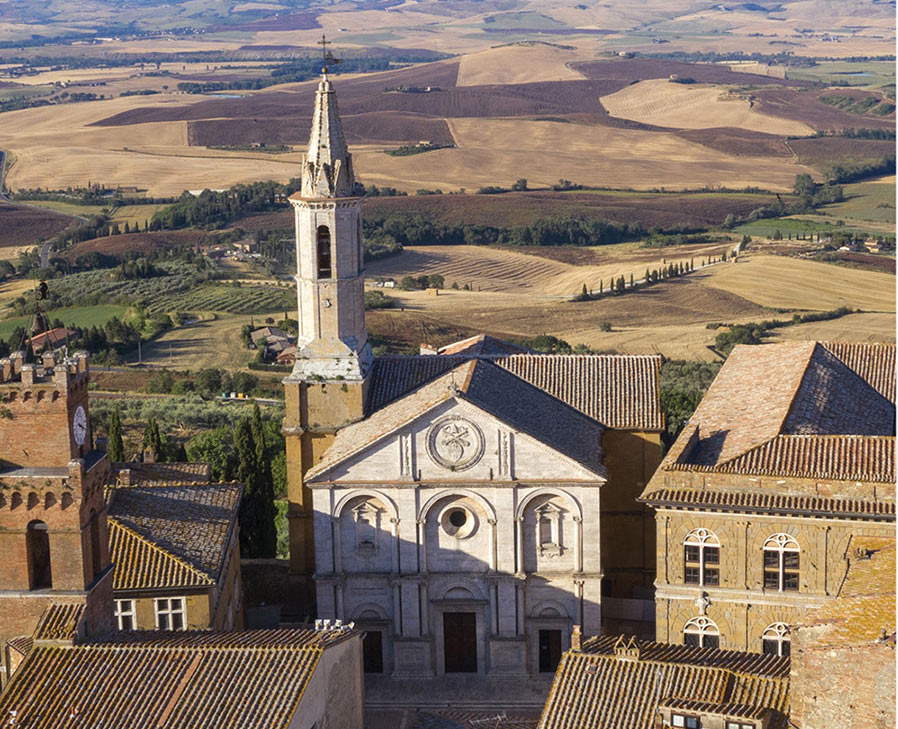
2. San Quirico d’Orcia
San Quirico d’Orcia, in the center of the valley made up of the famous rolling hills, is a medieval village that is still excellently preserved, complete with city walls, full of monuments to see and history to tell...and a splendid view of the Val d’Orcia and Mount Amiata. The town hall is located in the Renaissance palace of the Chigi family built by Cardinal Flavio Chigi with plans entrusted to architect Carlo Fontana, in Baroque style with a monumental facade and decorated inside with frescoes by Roman painters. In the main square inside the church of San Francesco are preserved two polychrome wooden statues by Francesco di Valdambrino and the Madonna by Andrea della Robbia (in carved, painted and gilded wood) that was originally inside the famous Vitaleta chapel, another place to visit in the countryside outside San Quirico where it is lost tiny amidst the typical Unesco-protected landscape. The village offers a refined Italian garden, the Horti Leonini (next to the medieval Porta Nuova), where the statue of Cosimo III de’ Medici stands among the hedges cut with geometric plays; and then again the Cassero Tower, the church of Santa Maria Assunta and theancient Romanesque collegiate church, built on a parish church, with a Latin cross base and a single nave with three portals, the largest of which is in the Lombard style with a round arch and six columns on each side, four of which rest on two sculptures of lions. Inside it is filled with works of art including a triptych by Sano di Pietro, a fresco by Girolamo di Benvenuto and a painting by Rutilio Manetti. A curiosity: not everyone knows that inside this collegiate church, the very young Federico Zeri decided to become an art historian. Or so he recounted.
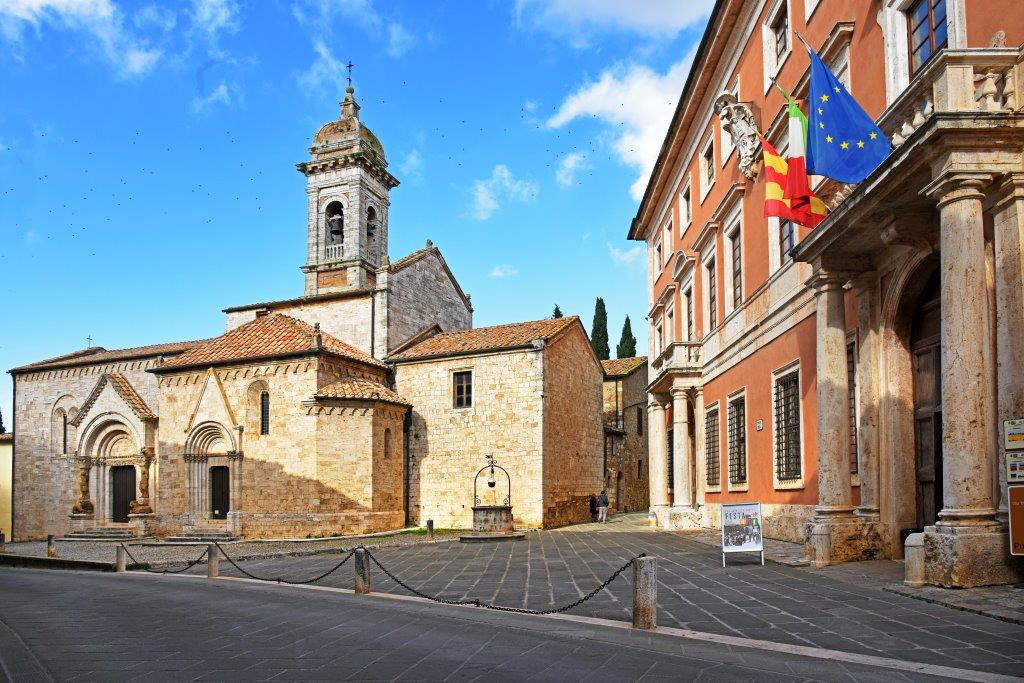
3. Montepulciano
Renowned for its good wine rightly defined as “Nobile,” on the border with the Val di Chiana we find Montepulciano: a Renaissance town with a very ancient history, Etruscan the first settlements on this hill ridge and medieval the urban layout, which perfectly preserves the traces of this prosperous past and rich in the many monuments to visit. Of great impact is Piazza Grande, about 2,500 square meters in area, with its characteristic L-shape where the unmistakable Palazzo Comunale, which will remind most people of the Florentine Palazzo Vecchio, the Cathedral of theAssunta, with many valuable works of art such as the triptych by Taddeo Bartolo or the Altar of the Lilies by Andrea della Robbia; the Pozzo dei Griffi e dei Leoni, designed by Antonio da Sangallo the Elder; the Palazzo dei Capitani del Popolo, that of the noble Tarugi family; and Palazzo Contucci. The best architects of the time passed through here, and a competition of ideas was even launched for the Cathedral, as we would say today, a testament to the high artistic and cultural vision that dwelled here
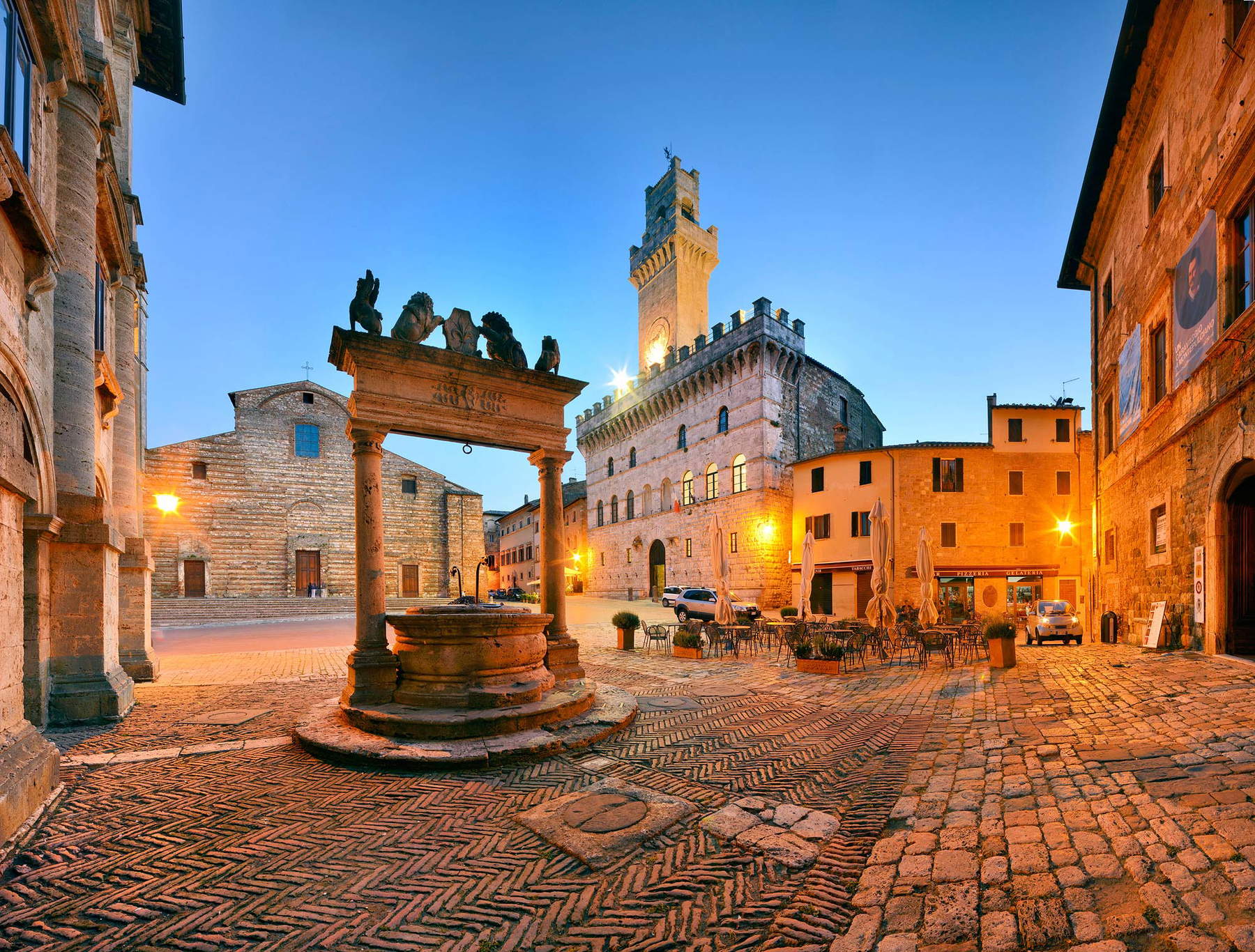
4. Bagno Vignoni
Bagno Vignoni is a hamlet of San Quirico d’Orcia within which a hot spring of thermal water (49 degrees centigrade) gushes from the water table of volcanic origin, and for this reason it has been exploited and enjoyed extensively since ancient times for its recognized benefit. During the sixteenth century a real large pool (49 meters by 29) was built to contain the water in what has been called the Piazza delle Sorgenti. Lorenzo the Magnificent, Pope Pius II and St. Catherine of Siena passed through here, to whom the loggia of the square and a chapel are dedicated. The water contributes to the atmosphere during the winter when at night the steaming pool can be seen with the water so hot that it evaporates on contact with the cold air. The power of the spring was also used to drive mills that were even dug into the rock.
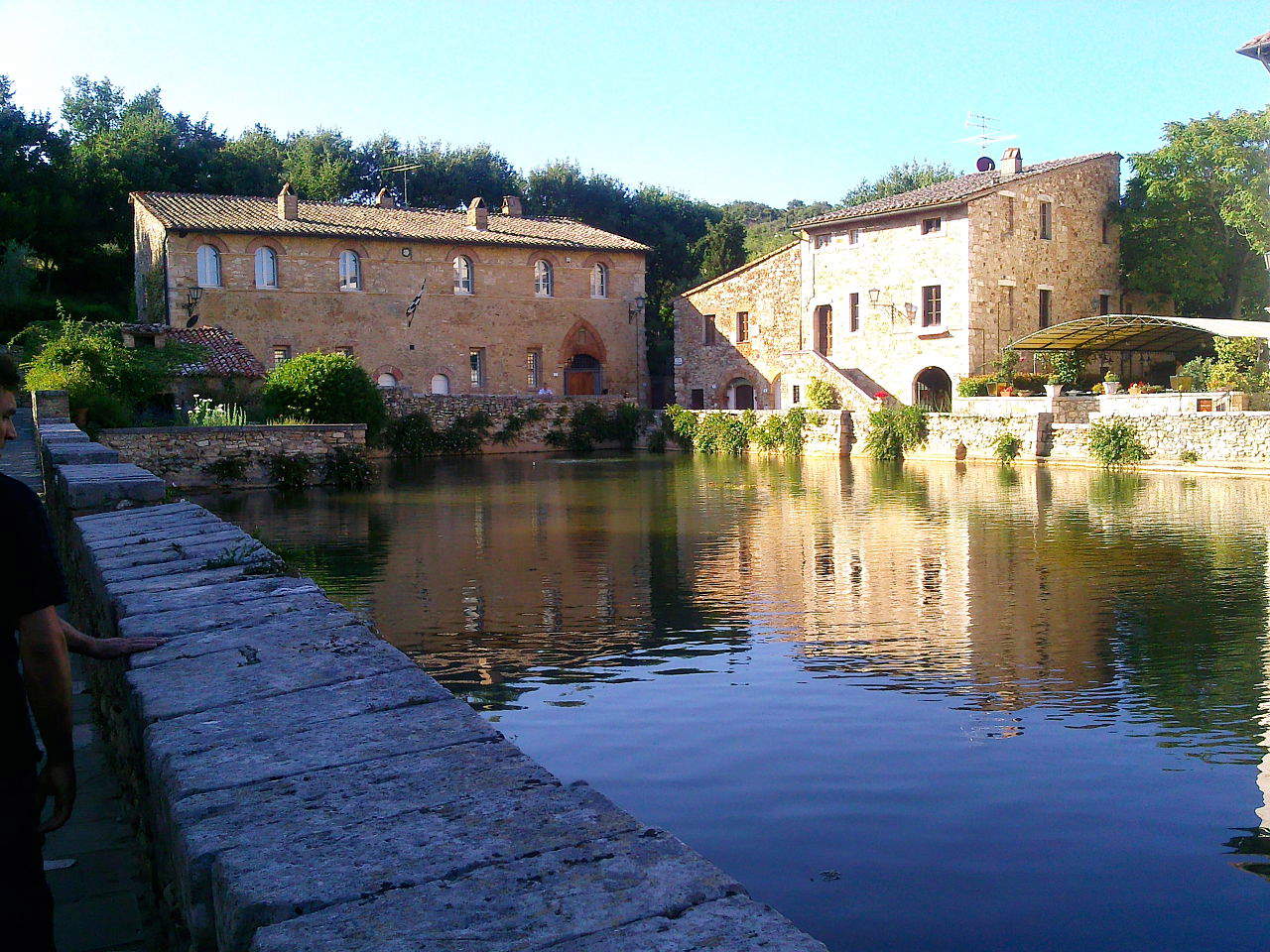
5. The chapel of Vitaleta
You will no doubt have seen the chapel of Vitaleta among the icons of the collective imagination that represent Tuscany: a tiny building in the middle of the countryside backed by two rows of cypress trees. In 2021 it was completely restored trying to return it to its original appearance. Its history is linked to the apparition of the Madonna and the statue by Andrea della Robbia, now kept in the Collegiate Church in San Quirico, but it is among the most photographed places in Tuscany because of the external context in which it stands out. Postcard landscape.
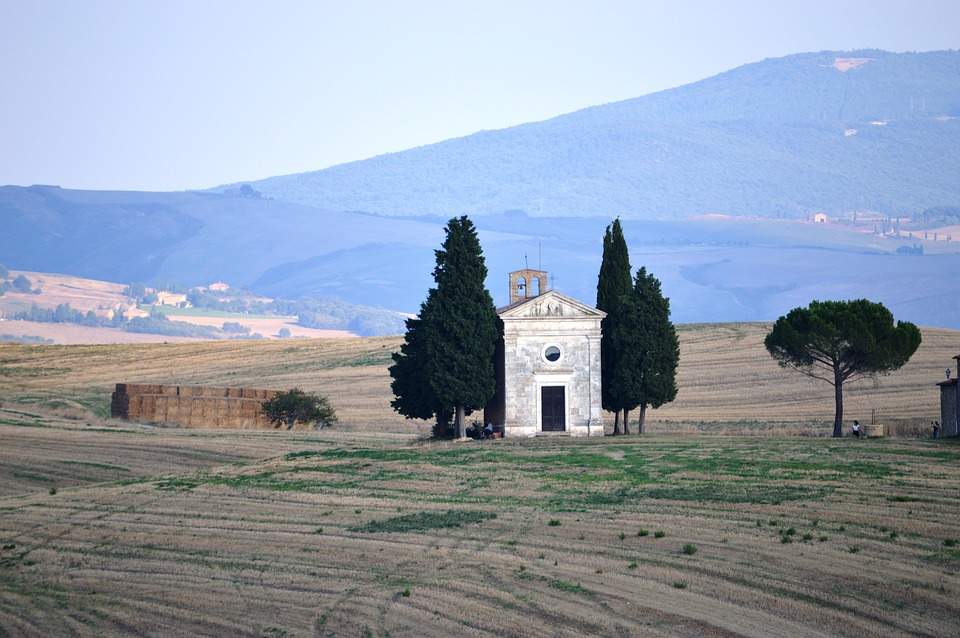
6. The Abbey of Sant’Antimo.
Not far from Montalcino, nestled in the countryside full of golden fields, vineyards and centuries-old olive trees, stands the Benedictine abbey of Sant’Antimo, among the best examples of Romanesque-style monastic architecture in Tuscany. Divided into three naves with alternating cross-shaped columns and pillars (and richly and variously decorated capitals: the depiction of Daniel in the lions’ den attributed to the master of Cabestany is worth admiring) and wooden truss ceilings-the central one-and cross vaults in the side ones (where the women’s galleries are above), theAbbey, all made of travertine rock (which gives it an iridescent sheen depending on the brightness of the day) has an ambulatory with three radial chapels with a semicircular plan from which the French influence of the style is evident. The facade in Romanesque forms appears incomplete with signs of what must have been four arches and a prothyrum enclosing the important portal with sculptural decoration. Equally important is the polychrome wooden crucifix on the high altar, beneath which is the crypt with an altar and 16th-century frescoed lunette. The bell tower (from an earlier period) with a square base is 27 meters high. The current appearance of the abbey dates back to 1118 but its origin is traced back as far as 781 when tradition tells us it was Charlemagne himself who wanted it built here as a sign of grace received.
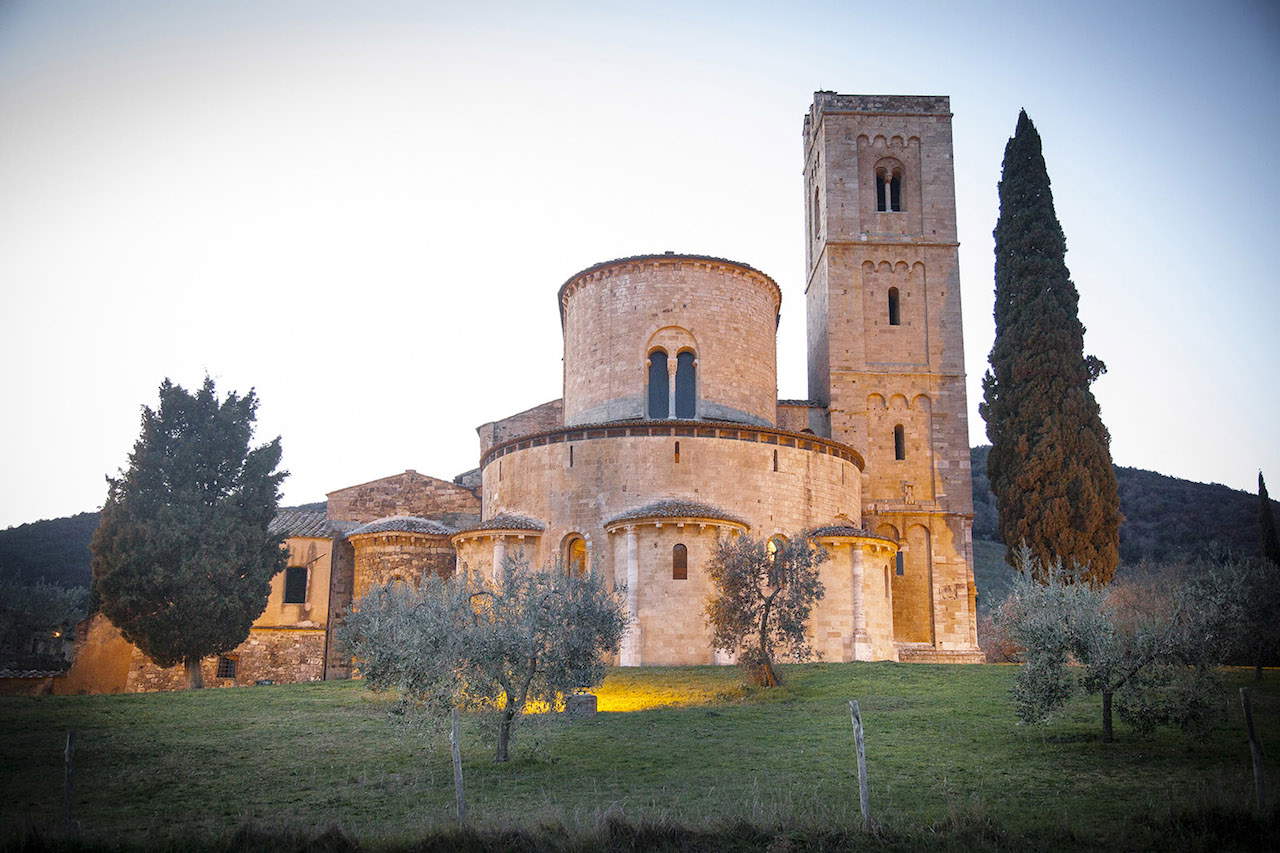
7. Montalcino
Famous worldwide for its Brunello, Montalcino is undoubtedly the capital of wine, but it also has a centuries-old history to discover and learn about. The medieval town developed around the fortress with its peculiar pentagonal shape that dominates the countryside unchallenged, perfectly preserved with its towers and walkway on the walls that can be walked . The Museo Civico Diocesano di Arte Sacra (Diocesan Museum of Sacred Art) is worth a visit, with a rich and articulate collection including a Crucifix by Giambologna. Particularly noteworthy is the Palazzo dei Priori with its soaring narrow and fine bell tower to the right of the building on whose facade are affixed the heraldic coats of arms of the podestas who have governed the town.
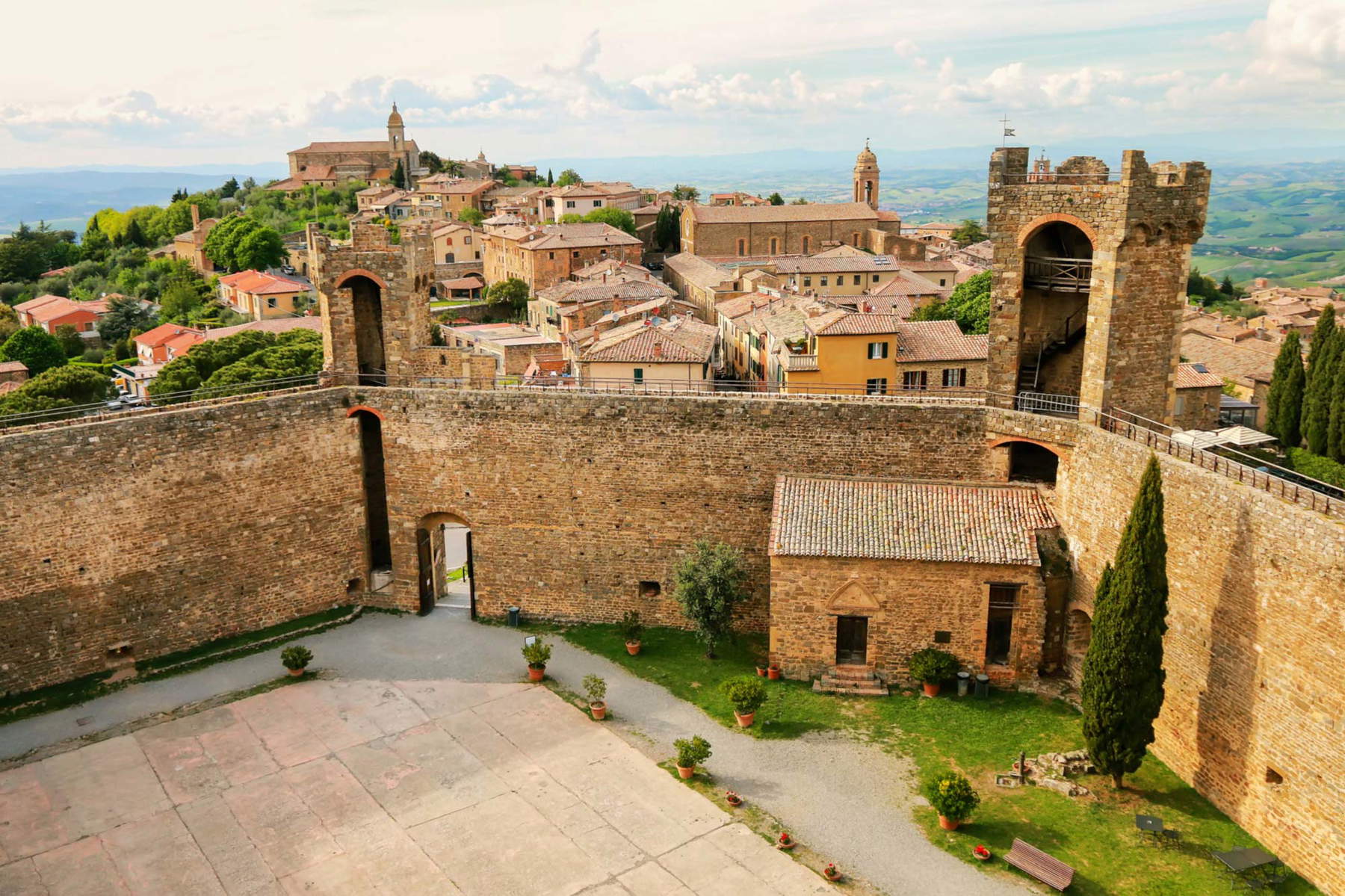
8. Radicofani
Unmistakable for its particular structure is the fortress of Radicofani, which, as narrated by Dante Alighieri and Boccaccio, was the refuge of the ’good’ brigand Ghino di Tacco, a local Robin Hood, and from whose tower the entire valley is controlled as far as the eye can see, a thousand meters above sea level on this World Heritage landscape. The fortress can be glimpsed tens of kilometers away, every part of it is accessible and can be visited, from the tunnels to the ramparts and the walkways on the walls, and today it is home to the museum that houses the archaeological remains found in the area. The small village of Radicofani at the foot of the fortress has two interesting places of worship to visit, such as the Romanesque-Gothic-style church of San Pietro, inside which there are glazed terracotta works by Andrea della Robbia and a polychrome wooden statue by Francesco di Valdambrino.
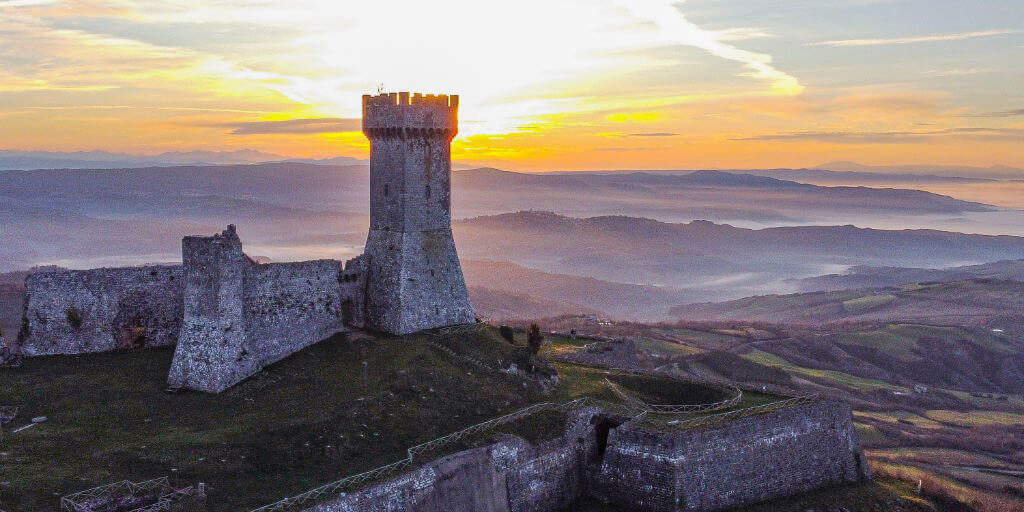
9. Castiglione d’Orcia
A typical medieval Tuscan village, Castiglione d’Orcia holds high the banner of authenticity and tradition typical of this valley. Here, too, we have a fort erected for defense and control (by the family of Count Tignosi da Tentennaro in the thirteenth century) and likewise we are in the presence of a spa that over the years has been widely enjoyed with its beneficial and relaxing sulfur waters. The power of the water, in Bagni San Filippo, has also created a spectacle for the eyes made by the limestone formation formed by its flowing and which they call the ’white whale’ here, because of its large, rounded, whitish features. It is named after St. Philip Benizi who, according to tradition, came to take refuge in the woods near the stream to avoid being named supreme pontiff. The cave he used to retreat is open to visitors. While in the Rocca Tentennaro it seems that St. Catherine of Siena, Patroness of Italy, stayed there. Art, culture and history are inextricably intertwined with Christianity.
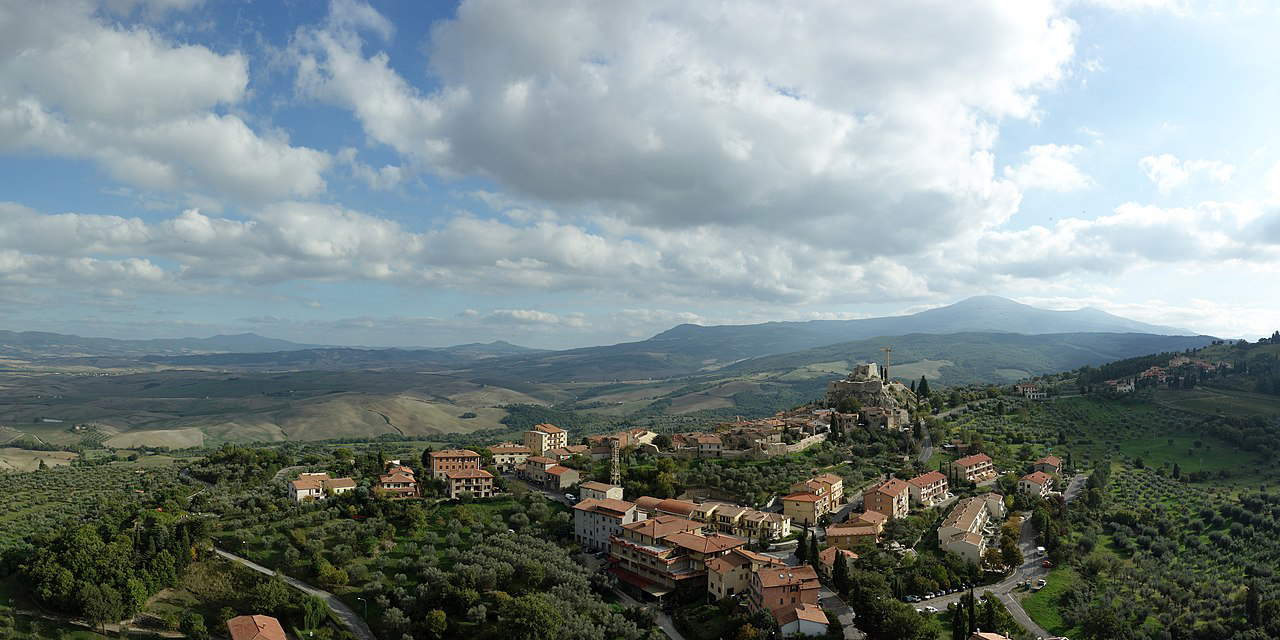
10. Monticchiello
In the administrative territory of the municipality of Pienza there is a medieval village surrounded by mighty turreted walls at the top of a hill to get to which one travels the iconic road made of curves propped up by cypress trees, an emblem of that Tuscany made of nature and history that here releases its charm: it is Monticchiello. Developed around a fortress overlooking the valley, among the stone-paved streets the houses are now inhabited by fewer than 200 inhabitants, preserving intact the authenticity of its glorious history. The keep dates back to the mid-13th century, seven towers are still preserved in the walls, five of which have a square base and two are round, and the parish church of Ss.also the T-shaped, Gothic-style parish church of Santi Leonardo e Cristoforo with its ogival portal surmounted by a rose window, a single nave, which preserves important frescoes of the Sienese school inside and where Pietro Lorenzetti’s Madonna di Monticchiello, now transferred to the Diocesan Museum in Pienza, was located.
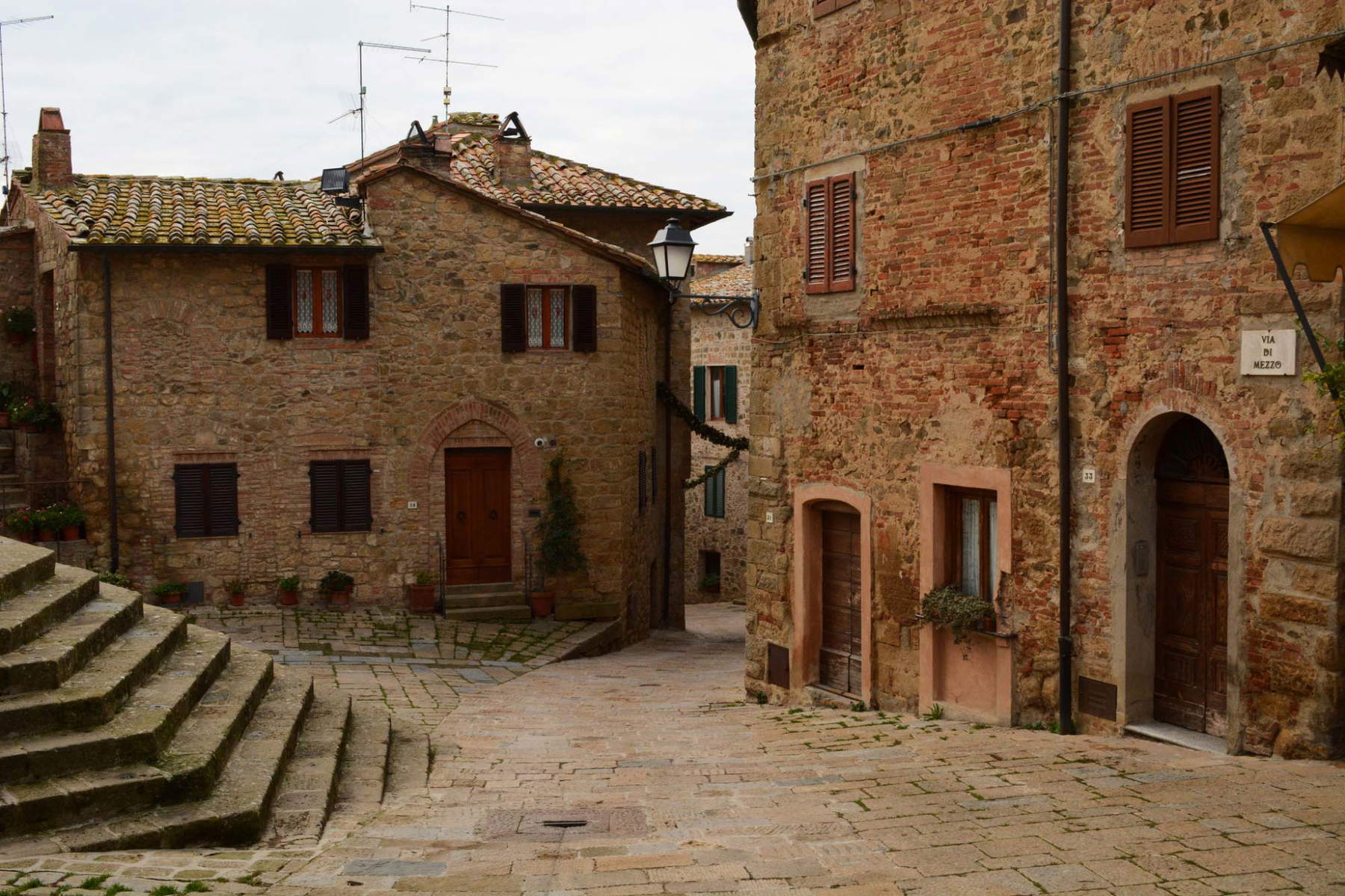
 |
| Val d'Orcia, what to see. Itinerary in 10 stages |
Warning: the translation into English of the original Italian article was created using automatic tools. We undertake to review all articles, but we do not guarantee the total absence of inaccuracies in the translation due to the program. You can find the original by clicking on the ITA button. If you find any mistake,please contact us.



























